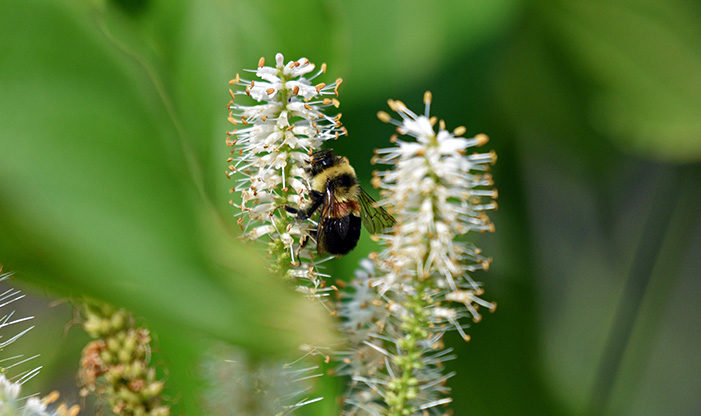Schlitz Audubon is utilizing a cutting-edge conservation practice as part of a local nonprofit partnership. Conservation Dogs Collective (CDCI) will assist our staff with the Bumble Bee Monitoring Project. The project will leverage the power of dogs’ noses to help us monitor threatened and endangered bumble bee species at the Center.
The Project
Although we’ve completed the Stormwater Wetland & Ravine Restoration Project, the Center is continuing the success of those efforts by helping maintain important ecosystems they support. A crucial piece of this system are our bumble bee populations. With the help of our CDCI partners, a Canine Keeper and her two Labrador Retrievers, we’ll be able to learn about which species are nesting within the project area, and what types of habitats they prefer. This information will not only guide our management of the land, but also helps protect the endangered populations.
You don’t usually expect to see any pets on the property when you visit. So, in the coming months, you might see these adorable, four-legged creatures working on the property. These are the conservation dogs who we’ve hired to do an important job at the Center.
The bee-monitoring project will begin the last week in June and take place a number of times throughout the summer. Although this is the first time Schlitz Audubon has worked with conservation dogs, we’re hoping to develop a long-term, fruitful partnership by incorporating them into other future projects.
The Importance of Bumble Bees
Bees are the heart of a healthy ecosystem. Without pollen transfer, most plants couldn’t produce seeds. Eighty-five percent of flowering plants require animals, usually bees, to move pollen. There are 20 species of bumble bees in Wisconsin, and the Center has confirmed nine on our property, including the federally endangered rusty patched bumble bee.
Why Use Conservation Dogs to Find Bumble Bees?
It’s notoriously difficult to find bumble bee nests as many bee species prefer to build them in dry, dark cavities, leaving nests to turn up in unexpected places. Some build nests underground, in places such as abandoned rodent holes, under sheds, and in compost heaps. A canine nose, containing 300 million olfactory receptors versus a human’s 6 million, is an accurate, efficient, and non-invasive tool for detecting elusive species. The CDCI dogs are professionally trained to sniff out the sweet, waxy scent of the bumble bee nests to help locate our pollinators.
Conservation dogs have been used to detect the scent of endangered, threatened, and elusive species since the mid-1990s. A conservation dog can be trained on a new scent in as little as a few hours and can learn to identify more than 20 target odors over the course of their career and can search for multiple targets simultaneously. Their natural abilities make them an invaluable resource for researchers and scientists.
About Conservation Dogs Collective
Conservation Dog Collective began its journey when they received a request to train a conservation dog for the Mequon Nature Preserve (MNP). They successfully trained Tilia, who went on to be a full-time staff member of the preserve, helping to locate wild parsnip rosettes and two species of salamanders. Seeing the potential of these dogs, CDCI began doing business in January 2017 under their original name, Midwest Conservation Dogs. They recently renamed themselves to support continued, strategic growth.
CDCI has worked with numerous partners throughout Wisconsin and beyond to provide conservation services, but this organization does more than that. Since its inception, this nonprofit has expanded its mission to provide educational services about their dogs, conservation, and the human-canine bond.
Each Canine Finder (working dog) lives with their Canine Keeper (loving parent) in a warm, positive-reinforcement-practicing environment where they get plenty of opportunities to live a fulfilled life. Living and working this way helps the organization shine a light on the human-canine bond, allowing the organization to connect with a greater community around the shared passion of people and the dogs they’re crazy about.
How You Can Help Protect Our Native Bumble Bees
If you’d like to help native bumble bees, one important thing you can do is plant a native garden. Native plants are co-adapted to local wildlife, and they provide an excellent food source for pollinators. And if you’re visiting the Center and you happen to see the CDCI team at work, please give them their space. The conservation dogs have an important job to focus on.
Stay tuned. Once the project has progressed, and we have results, we will provide an update to let you know what we have discovered.


